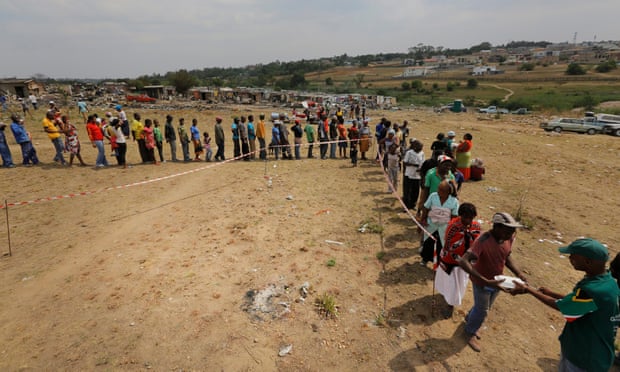Jennifer Lentfer
Less than 2% of humanitarian aid goes directly to local NGOs, but Jennifer Lentfer argues that grassroots groups are best placed to help those in need

Locals give out food after a fire in an South African township. Photograph: Kim Ludbrook/EPA
Working in development
This article is more than 7 years old
Five reasons funding should go directly to local NGOs
This article is more than 7 years oldJennifer Lentfer
Less than 2% of humanitarian aid goes directly to local NGOs, but Jennifer Lentfer argues that grassroots groups are best placed to help those in need
Supported by
theguardian.org
About this content
Fri 13 Nov 2015 08.00 GMT
12
Acohort of small villages comes together to lobby for protection of a local forest upon which they depend. A group of church women gather under a tree to plan for how they will get orphaned children back into school. A self-help group forms a cooperative to get better prices for their products.
Dhananjayan Sriskandarajah’s discussion of why donors seem unable or unwilling to directly fund local organisations like these was certainly indicative of the international aid and philanthropy world. As he also mentioned, there is a growing community of international small grantmakers that know how to find and fund effective grassroots initiatives.
Aid agencies continue to struggle to make such concepts as 'community participation' and 'local empowerment' a reality
Here’s why we focus our efforts on getting funding down to local NGOs:
1. Social and systemic injustice has deep rootsAid agencies and social enterprises continue to struggle to make such concepts as “community participation” and “local empowerment” a reality in their interventions. But even with the most comprehensive needs assessment or study, local contextual knowledge will never be fully understood by outsiders.
Small international grantmakers look for dedicated and embedded local partners who are working hard to understand and address their own problems. We believe that the people whose lives are most affected by social problems are the best judges of strategy.
2. Grassroots organisations are part of the social fabric of the communityEffective local organisations are embedded in the communities they serve because of their proximity, both physically and socially, to local people. They are locally rooted institutions that have vital expertise in the interpersonal and caring relationships in people’s everyday lives.
When a storm hits, violence breaks out, or a case of abuse in a family is discovered, local groups snap into action to make sure people are safe and cared for. As the first responders in a community, grassroots organisations are best situated to get help to those who need it most.
3. The larger the institution, the more resources are shifted to perpetuating its own existenceComplex and interconnected global problems like poverty, climate change, and conflict are challenging to large, risk-averse institutions. In contrast, the lack of prescribed or strict procedures for decision-making in local organisations help them to remain more adaptive to arising needs and inherent complexities. They are able to mobilise local resources and be responsive to their communities needs.
People who are making change no longer want to be dependent on international bureaucracies that make local leaders wait endlessly for funding to trickle down to them, and which often comes with excessive administrative burdens, restrictions, and reporting.
4. Effective grassroots organisations have staying power at the local levelMost of the development sector is ruled by annual reports and three-year project cycles, which is very different from the time needed to see transformative change. When organisations are not externally catalysed or are led entirely by people from the same communities they serve, they will more likely remain in those communities, working on these issues, long after international actors have left.
When grassroots organisation spring from existing, lasting, and mutual relationships, their staff and volunteers often know the people they serve on a one-on-one basis, resulting in a personal stake and a long-term commitment to the success of their efforts.
Five reasons donors give for not funding local NGOs directly
Dhananjayan Sriskandarajah
Dhananjayan Sriskandarajah
Read more
5. Grassroots grantees get resultsGrantees that San Francisco-based Idex supports, for example, have been globally recognised for their gamechanging models and solutions. Goldman Environmental Prize winner Desmond D’sa’s organisation, the South Durban Community Environmental Alliance, developed a “bucket brigade” to enable community members to collect air samples and identify pollutants in industrial areas plagued by environmental discrimination (marginalised communities are more likely to suffer from pollution). They then spearheaded a new national law that establishes air quality and emissions standards for South Africa, shut down a toxic landfill, and are now fighting the Durban port expansion, which would wreak havoc on surrounding communities.
International small grantmakers may not have volumes of external evaluations or randomised control trials as proof of concept, but they are able to recount story after story about their grantees’ accomplishments and triumphs. They are willing to challenge the notion of “small” as insignificant, when the quality and integrity of the work is seen in local solutions having lasting impact.
Of course not all local NGOs are created alike, nor are all funders. And grantmaking of any size can create or reinforce dependency relationships, as well as perpetuate, rather than challenge, existing power structures.
However, the combined experience and wisdom of seasoned international small grantmakers is an untapped resource for international aid, philanthropy, and social enterprise to learn how to get local leaders the resources they need to address their own priorities. It’s time to make room at the table for more local organisations that hold great promise and potential.
We are demonstrating what can be done when trusting and lasting relationships are built with the people leading the change.
Jennifer Lentfer is the creator of how-matters.org and director of communications at Idex, International Development Exchange. Follow @IDEX on Twitter
Join our community of development professionals and humanitarians. Follow @GuardianGDP on Twitter.
Source: Guardian News & Media Limited or its affiliated companies.
Original content:
https://shorturl.at/rOPX3